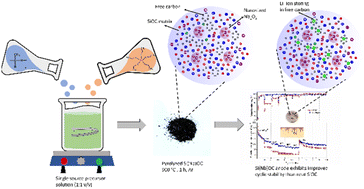New insights into the electrochemical performance of precursor derived Si(Nb)OC composites as anode materials for batteries†
Abstract
This work represents a first attempt to synthesize Si(Nb)OC ceramic composites through the polymer pyrolysis or the precursor-derived ceramics (PDC) route for use as a hybrid anode material for lithium-ion batteries (LIB). Electron microscopy, X-ray diffraction, and various spectroscopy techniques were used to examine the micro/nano structural features and phase evolution during cross-linking, pyrolysis, and annealing stages. During the polymer-to-ceramic transformation process, in situ formation of carbon (so-called “free carbon”), and crystallization of t-NbO2, NbC phases in the amorphous Si(Nb)OC ceramic matrix are identified. The first-cycle reversible capacities of 431 mA h g−1 and 256 mA h g−1 for the as-pyrolyzed and annealed Si(Nb)OC electrodes, respectively, exceeded the theoretical Li capacity of niobium pentaoxide or m-Nb2O5 (at approximately 220 mA h g−1). With an average reversible capacity of 200 mA h g−1 and close to 100% cycling efficiency, as-pyrolyzed Si(Nb)OC demonstrates good rate capability. X-ray amorphous SiOC with uniformly distributed nanosized Nb2O5 and graphitic carbon structure likely provides stability during repeated Li+ cycling and the formation of a stable secondary electrolyte interphase (SEI) layer, leading to high efficiency.



 Please wait while we load your content...
Please wait while we load your content...